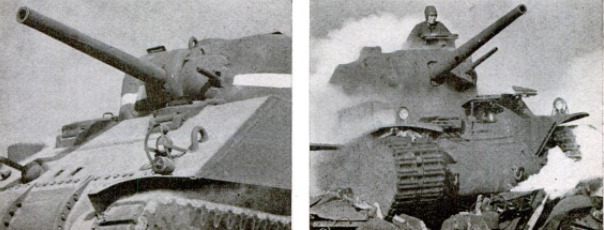-
Titolo
-
America's best tanks
-
Article Title and/or Image Caption
-
Title: Why America's tanks are the world's best
-
Subtitle: Guns, speed, armor, durability - this have given us the lead on the proving grounds of the war
-
extracted text
-
THE battlefield value of a tank depends
on three qualities: the power of its guns,
its ability to take those guns where they
can do the greatest possible damage to the
enemy, and its mechanical durability.
In the fighting on the African desert
which was climaxed by Rommel's rout,
American light and medium tanks lend-
leased to the British—a few of them han-
dled by American crews—consistently out-
matched German tanks of their classes in
all of these qualities. Our 13%-ton light
tank proved itself to be the hardest-hitting,
fastest, and mechanically most dependable
light tank on the vast and dangerous prov-
ing ground. Our M-3 medium tank, which
the British call the General Grant, outshot,
outspeeded, outlasted, and generally outper-
formed the German 18-ton Mark III and
22-ton Mark IV mediums which had been
more than a match for the British Valen-
tines and Matildas of the same respective
weights.
As soon as they got into action, the Amer-
ican medium tanks proved that they had
more powerful guns than the German
fighting vehicles. They also proved to be
much better than the German medium
tanks for the job of carrying their guns and
gun crews through heavy fire. Their su-
perior speed and greater maneuverability
made them harder to hit, and when they
‘were hit the armor-piercing projectiles from
the German gun-howitzers which had
punched through the 2 1/2-inch main armor
of the British mediums had much less effect
on their tougher and possibly thicker
plates. Even the much-touted German
88-mm. high-velocity antitank guns weren't
sure death to the sturdy General Grants—
one of which sustained eight hits by 88-mm.
projectiles without being penetrated by them.
In mechanical dependability and dura- |
bility our tanks were almost immeasurably
superior to those of the enemy. Ninety of
our light tanks went through an entire |
month of battle-front service with only 12
minor mechanical failures. A captured re-
port of a German workshop company shows
that after a 900-mile desert trek 44 out of
65 Mark III's were out of service because
of serious engine troubles which included
frozen pistons and broken connecting rods.
These American-built tanks were early
models of types which now have been great-
ly improved. Maj. Gen. Jacob L. Devers,
chief of our Armored Force, says that they
wouldn't stand a chance aginst the tanks
now coming off our production lines.
Our new tanks are the best in the world
because they have been made that by over
20 years of hard work, careful planning,
and patient experimenting and testing by
the tank experts of the Army Ordnance De-
partment, ably assisted by some of the out-
standing engineers of the automobile indus-
try serving on tank committees of the
Society of Automotive Engineers.
When the United States entered World
War I, the tank, first used by the British
in 1916, had been developed into a moder-
ately efficient and highly spectacular weap-
on which appealed strongly to automobile-
minded Americans. In France several bat-
talions of our newly organized Tank Corps,
using equipment borrowed from the British
and French, fought in our St. Mihiel and
Meuse-Argonne offensives and helped the
British break the Hindenburg Line. On this
side of the Atlantic, Army Ordnance officers
and civilian automotive engineers worked
almost as hard over the difficult job of de-
signing and building American tanks.
The first of their conceptions to get be-
yond the blueprint stage was the gas-elec-
tric tank built in 1918 by the Holt Tractor
Company—pioneer producers of endless-
tread tractors—and the General Electric
Company. It was powered by a 90-hp.
gasoline engine which drove a generator
that supplied current to two electric mo-
tors which drove the tracks.
The next tank produced in America was
a 50-tonner designed and built by the Army
Engineers. It was driven at a top speed
of four miles per hour by a pair of 250-hp.
steam engines and its principal weapon was
a flame thrower intended for attacks on
concrete pillboxes—an idea which the Ger-
mans have made use of in this war. An-
other of the very early American tanks
was the Skeleton—a daddy-longlegs tractor
with a small armored body slung between
its nine-feet-high and 25-feet-long tracks.
None of these experimental tanks per-
formed impressively enough to encourage
the building of a second model. As tanks
were needed badly, the Ordnance Depart-
‘ment arranged with several manufacturers
for the building of a copy of the French Re-
‘nault, which was called the Six-Ton M 1017
Tank. Over 900 were produced in 1918 and
1919. For years they were the only usable
tanks ‘in the Army, and some National
Guard companies still were equipped with
them when they were ordered into Federal
service in 1040. The Ordnance Department
also built 100 Mark VIII 43-ton tanks of
modified British design. The first one fin-
ished was tested two days after the war
ended. This old Mark VIII is the tank
represented on the collar insignia of the
Armored Force.
Only a few of these American-built tanks
were sent overseas, and none of them were
used in action.
The 15 years following the end of World
War I were very lean ones for the Army.
Far-sceing officers were urging the neces.
sity for u degree of mechanization, but
Congress wouldn't provide the money to
buy the machines. Appropriations were so
meager that the three Ordnance officers
Who deserve chief credit for the peerless
American tanks of today had to cut a lot
corners to go on with their experimental
work. One of these officers is the Army's
present Chief of Ordnance, Maj. Gen.
Levin H. Campbell, Jr. The other two are
Gladeon M. Barnes and John K. Christmas,
both now brigadier generals and key men
in our gigantic tank-production program.
J. Walter Christie, former race driver,
Worked in close collaboration with the Ord.
nance men. The suspension and many other
superior mechanical features of our tanks
were of his invention.
Between 1920 and 1935 European armies
built tanks by the thousands. We built a
total of 31—but each of those experimental
models was an improvement over the one
which had preceded it. Engine power was
increased steadily. Tn 1926 an air-cooled
engine was used for the first time. Sliding-
gear transmissions replaced the old plane-
taries. Speeds were increased from the
five or six miles per hour of the 1918 models
to over 20 miles per hour. Steering and sus-
pension methods were improved, making
tanks more maneuverable and steadier gun
platforms. The toughness of tank armor
was increased; in 1933 the first all-welded
tank hull was produced at the Watertown
Arsenal.
From those fifteen years of hard work our
Army Ordnance tank specialists acquired
the know-how to design and build tanks
that would compare favorably with those
of any other army. When at last Congress
heeded the urgings of Gen. Douglas Mac-
Arthur (then Chief of Staff) to the extent
of appropriating funds for the building of
283 light tanks, they were ready with the
design of the M2A3. It weighed 10 1/2 toms,
and its 270-h.p. air-cooled airplane-type
engine gave it a road speed of well over
35 miles per hour. Its tracks, driven by
front sprockets and rolling over four bogie
wheels on each side which supported the
weight of the body, were made of a newly
developed long-wearing and heat-resisting
rubber composition set in steel blocks. In-
fantry tanks had double turrets; the mech-
anized cavalry
model, called a combat car, weighed a ton
less and had a single turret. Both models
were armed with .50 caliber and .30 caliber
machine guns.
Our Ordnance officers were convinced
that the M2A3 was the best light tank in
the world. Events soon proved that they
were right. In the spring of 1938 the
German Army—by then the acknowledged
leader in mechanization—invaded Austria
without having to do any fighting. Mechani-
cal failures on the road made casualties of
seven percent of its tanks. A few weeks
later our Mechanized Cavalry Brigade
marched 700 miles over hilly and blistering-
hot Southern roads in four days. Eighty-
six combat cars started the march, and 86
finished it under their own power.
The M2A3, built at the Rock Island Ar-
senal, was the first modern fighting vehicle
issued to the Army. The more heavily
armored M2Ad4, produced in quantity by
the American Car and Foundry Company,
soon superseded it as the standard tank of
its class. The much-improved M-3 light
tank, armed with a 37-mm. gun and ma-
chine guns—now being built in large num-
bers—is its direct descendant.
In 1938 Congress authorized the building
of 18 medium tanks—enough to equip an
entire tank company! The Ordnance De-
partment was ready with plans and speci-
fications for the 18-ton, 32-miles-per-hour
Medium M-2, armed with a 37-mm. gun.
From it were developed the M2A1’s, a num-
Der of which were issued to troops in 1940.
Reports from American observers at the
Battle of France emphasized the need for
more heavily armed tanks. When Congress
appropriated funds for the building of what
then seemed a large number of medium
tanks, it was decided to design a new model
with 2 75-mm. gun in a side turret in addi-
tion to the 37-mm. in the upper turret. Be-
cause of the experience gained during the
long development period, designing the
Medium M-3 took only a few months and
early in the spring of 1941 production was
started by the American Locomotive and
Baldwin Locomotive companies and the
Chrysler Corporation.
In the African battles before our in-
vasion the M-3 proved itself to be by far
the best tank on the desert. But that didn’t
satisfy our Ordnance tank experts. They
wanted to give our Armored Force an even
better medium tank, and they did it by
designing the Medium M-4.
Captured German, Italian, and Japanese
tanks have been subjected to every conceiv-
able practical and engineering test by our
Ordnance officers. These tests have con-
firmed. the strong battlefield evidence that
they aren't nearly as good as ours.
One of the reasons is that, type for type,
ours have thicker and better armor than
those of our enemies. The German light
tanks, with armor only 7/10 inch thick,
give the crews so little protection that they
no longer are used for serious combat.
The Nazi designers made the same fatal
mistake with their Mark IV medium tank.
Its original 1 1/2-inch-thick body armor has
been strengthened at especially vulnerable
spots by bolting one-inch-thick plates over
it, but these reinforcements aren’t nearly so
strong as solid plates would be.
The exceptionally high quality of Ameri-
can tank armor is the result of many years
of experimental and development work in
Government arsenals. Rolled face-hardened
plate, which keeps out the bullets of high-
powered machine guns, is used on light ve-
hicles. Rolled homogeneous plate, which
absorbs the terrific shock of large-caliber
projectiles and also affords sure protection
against machine-gun fire, is used on some
of our heavier tanks. Tank plates now are
welded together instead of being riveted.
‘The use of cast armor is increasing. It can
be cast into curved and sloping plates
which deflect many projectiles. Our new
M-4 medium tank has a cast-armor body.
Another, and very important, reason for
our tanks’ superiority is that, ton for ton,
their light and compact airplane-type radial
air-cooled engines are about twice as pow-
erful as the engines of most European-built
tanks. The ratio of engine power to vehicle
weight of World War I tanks was about
six horsepower per ton; in our modern
tanks it is about 18 horsepower per ton.
This high power-to-weight ratio makes
them faster than opposing tanks and en-
ables them to maintain speeds of from 10
to 20 miles per hour in sand or mud and on
steep slopes and over obstacles. Speed is
almost as good protection as armor—the
faster a tank moves the fewer shots hostile
tanks and antitank guns can get at it after
it comes within their effective range.
Synchro-mesh transmissions now are used
on most of our tanks, but several types of
electrical and hydraulic variable-speed
transmissions are being developed. Future
use of one of them would eliminate the
clutch. Our controlled-differential steering
-
Autore secondario
-
Arthur Grahame (Article Writer)
-
Lingua
-
eng
-
Data di rilascio
-
1943-03
-
pagine
-
120-127, 218, 220-221
-
Diritti
-
Public Domain (Google Digitized)
-
Archived by
-
Matteo Ridolfi
-
Marco Bortolami (editor)
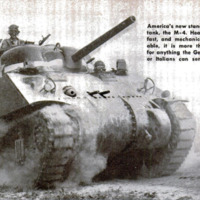 Schermata 2022-02-22 alle 14.28.49.png
Schermata 2022-02-22 alle 14.28.49.png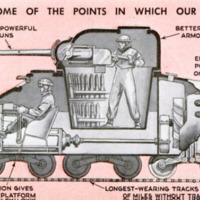 Schermata 2022-02-22 alle 14.29.00.png
Schermata 2022-02-22 alle 14.29.00.png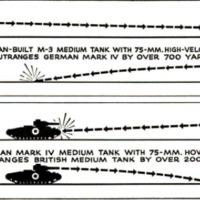 Schermata 2022-02-22 alle 14.29.14.png
Schermata 2022-02-22 alle 14.29.14.png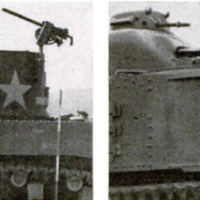 Schermata 2022-02-22 alle 14.29.21.png
Schermata 2022-02-22 alle 14.29.21.png Schermata 2022-02-22 alle 14.29.30.png
Schermata 2022-02-22 alle 14.29.30.png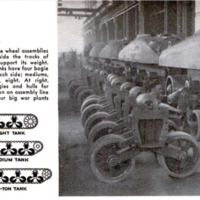 Schermata 2022-02-22 alle 14.30.40.png
Schermata 2022-02-22 alle 14.30.40.png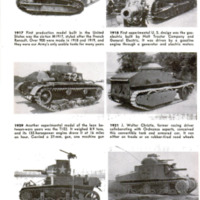 Schermata 2022-02-22 alle 14.30.55.png
Schermata 2022-02-22 alle 14.30.55.png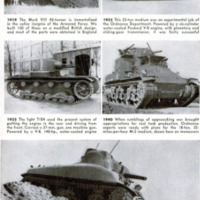 Schermata 2022-02-22 alle 14.31.06.png
Schermata 2022-02-22 alle 14.31.06.png



